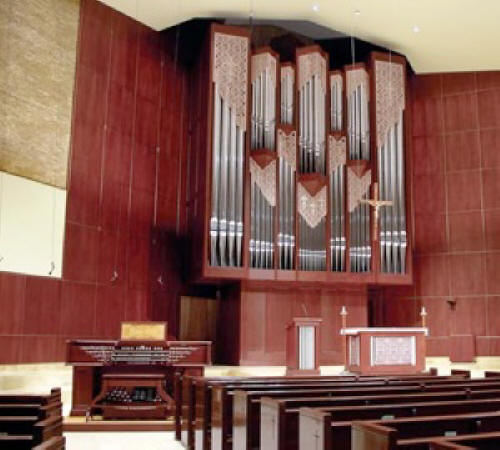|
Builder: Lively-Fulcher Organ Co (2001) Manuals: 3 Ranks: 67 Stops: 49 Action: Blackinton slider, electro-pneumatic GRAND ORGUE 16 Montre 61 8 Montre 61 8 Flûte a cheminee 61 8 Flûte harmonique 61 8 Violoncello 61 4 Prestant 61 4 Flûte overte 61 2-2/3 Quinte 61 2 Doublette 61 V Fourniture 305 8 Trompette 61 4 Clairon 61 Tremulant Octaves graves Recit sur G.O. Positif sur G.O. Bombarde sur G.O. POSITIF EXPRESSIF 8 Montre 61 8 Bourdon 61 8 Flûte douce 61 8 Flûte céleste 49 4 Prestant 61 4 Flûte conique 61 2-2/3 Nazard 61 2 Doublette 61 2 Quarte de nazard 61 1-3/5 Larigot 61 1 Fourniture IV 244 8 Trompette 61 8 Cromorne 61 Tremulant Octaves graves Recit sur Positif Bombarde sur Positif Positif unison off BOMBARDE (floating) 16 Tuba magna 8 Tuba mirabilis 4 Cor harmonique 8 Cornet V |
 |
|
RECIT EXPRESSIF 16 Bourdon 61 8 Diapason 61 8 Viole de gambe 61 8 Voix céleste 61 8 Cor de nuit 61 4 Prestant 61 4 Flute octaviante 61 2 Octavin 61 2 Plein Jeu IV 244 2-2/3 Cornet II 122 16 Basson 61 8 Trompette harmonique 61 8 Hautbois 61 8 Voix humaine 61 4 Clairon harmonique 61 Tremulant Octaves graves Tower Bells |
|
|
PEDALE 32 Contre soubasse Walker digital 16 Grosse flute 32 16 Montre (GO) 16 Soubasse 32 16 Bourdon (Recit) 8 Montre 32 8 Flûte 12 8 Bourdon 12 4 Prestant 12 4 Flûte ouverte 12 2-2/3 Fourniture IV 128 32 Contre bombarde 12 16 Bombarde 32 16 Basson (Recit) 8 Trompette 32 4 Clairon 12 |
|
|
In 1997, Fr. John Forliti, Pastor, appointed Dr. Merritt Nequette
and a parish committee to lead an organ project at St. Olaf. The
committee enlisted the services of Dr. Jonathan Biggers, a
recognized organ consultant. After a thorough study, Lively-Fulcher
Organbuilders of Alexandria, Virginia, were chosen to build the new
instrument which was installed and completed in July, 2001. The organ was inaugurated in a series of concerts in 2002 beginning on February 9 with a service of blessing by Archbishop Harry J. Flynn, Archbishop of St. Paul and Minneapolis, and organ recital performed by Dr. Lynn Trapp, Director of Worship and Music, Organist, at St. Olaf Church. A hymn text by Delores Dufner, OSB was commissioned for the occasion. The series of inaugural concerts featured: a recital and master class by Swiss organ virtuoso, Guy Bovet; a program of organ and contemporary music with Twin Cities artists; Pipedreams Live, hosted by Michael Barone of Minnesota Public Radio and performers of the Liturgical Organists Consortium; field days for elementary students to learn about the king of instruments; and an organ and orchestra concert with Dr. Jonathan Biggers, organist, and the Kenwood Chamber Orchestra, orchestra in residence at St. Olaf Church, conducted by Ken Freed. This concert included the premiere of a commissioned work for organ and orchestra composed by Richard Proulx. The instrument has 61 stops and 67 ranks (49 independent registers) playable over five divisions, Grand Orgue, Récit Expressif, Positif Expressif, Bombarde and Pedale. The manual and pedal key actions make use of electric slider windchests and the stop action is electric, complete with state of the art combination action, 256 levels of memory and a sequencer. The wind supply is regulated by a traditional bellows system linked to the wind chests by wooden wind lines. The console is built in a low profile, curved jamb configuration to enhance the organist's ability to follow the Liturgy and conduct the choir. The console has natural keys covered in bone and sharp keys of solid ebony. The internal layout of the divisions within the organ case places the Positif Expressif centrally in the lower middle of the case and the Grand Orgue above that with the Récit Expressif behind the Grand Orgue. The Bombarde reeds are located in the Positif box and the Pedale division is divided on either side of the manuals and behind the 16-foot Pedal towers in the case. The casework, constructed of African mahogany, takes its inspiration from the contemporary architecture of the room and has simple Scandinavian design elements yet a firm traditional layout. The façade pipes are made of 72% tin and include pipes from the Grand Orgue Montre 16', Montre 8' and Pedal Montre 8'. The organ is completely housed within its own freestanding casework and because of the deep gallery around three sides of the room is positioned at the front center of the church to enable it to fill the room with sound. A Cymbelstern stop - a group of small bells - is provided on the instrument and the church's tower bells can be played from the Récit keyboard. The design of the pipe shades for the instrument is tied to the rich traditions associated with St. Olaf. They are made of basswood with patterns of dragons, eagles and serpents which are found in the Book of Kells. These designs are slightly earlier than King Olaf's time, but they are strong Scandinavian symbols from the period. The cross piercing the crown is based on an 8th century piece made for St. Rupert. |